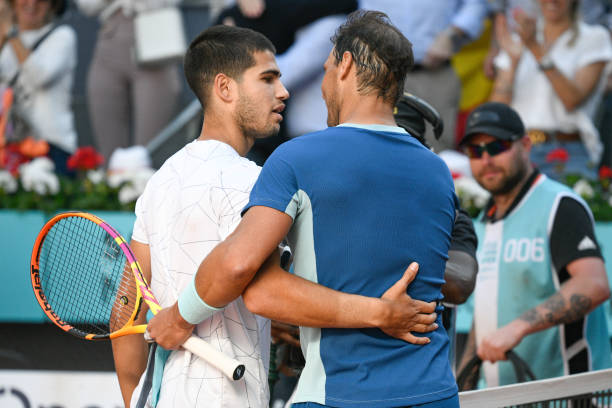In time, “Madrid 2022” might become short-hand for the type of great, genuinely historic, changing of the guard battle between one era of men’s tennis and another. In becoming the first man ever to beat Rafael Nadal and Novak Djokovic on consecutive days on clay, Carlos Alcaraz has surely proved that all the hype about him is, if anything, an understatement and that, as Sacha Zverev said after Alcaraz had beaten him in the Madrid Final, he is already the best male tennis player in the world.
But where does Madrid 2022 rank in the great inter-generational contests in men’s tennis? Well, here are five earlier changing of the guard battles from the last 50 years, encompassing almost the entire Open Era, that bear comparison with Alcaraz’s astonishing feat.
2001: Federer beats Sampras in the 4th Round of Wimbledon
Fittingly, the obvious event to compare Alcaraz’s triumph in Madrid with was the breakthrough moment of his own tennis hero and the man who he has most closely modelled his stupendous shot-making on, Roger Federer. At Wimbledon in 2001, the then 21-year-old Federer, who had already been tipped for stardom for several years, finally proved that all the predictions about his own potential greatness were justified when he beat his own tennis hero, Pete Sampras, in the fourth round at Wimbledon, triumphing in a classic five-set grass-court match, 7-6, 5-7, 6-4, 6-7, 7-5.
It was the only time that the two greatest grass-court players ever played each other in a professional match, but their Wimbledon 2001 encounter was entirely befitting of such a historic meeting. Federer edged the first set on a tie-break (the first of two in the match); Sampras fought back to take the second, narrowly; Federer then surged again in the third set; Sampras once more levelled when he dominated the fourth-set tiebreak 7-2; before Federer finally won the fifth set and promptly collapsed in tears on the grass, in disbelief at having beaten the man who had most inspired him to become a tennis player.
It is worth noting that Federer did not go on to win Wimbledon that year, as he was beaten in four sets by Tim Henman in the quarterfinal. Indeed, it would be another two years before Federer finally proved conclusively that he was a great grass-court player when he won the 2003 Wimbledon title against Mark Philippoussis. Nevertheless, it was in the fourth round in 2001 when he broke Sampras’s iron-grip on the Wimbledon title (the great American would play the tournament just one more time, losing to a less heralded Swiss, Georg Bastl, in the second round in 2002) and put himself on the road to grass-court domination.
1990: Sampras beats Lendl, McEnroe and Agassi to win the US Open
When Sampras lost to Federer in 2001, he must have had flashbacks to his own breakthrough as a player, when he beat Ivan Lendl, John McEnroe and Andre Agassi in the quarterfinal, semi-final and Final respectively of the 1990 US Open. Then, he had been the virtual unknown coming from seemingly nowhere to beat three established stars (although Agassi was only a year older than Sampras, he was far more well-known and far higher-ranked at that point) and announce himself as a potential future great.
Unlike Federer at Wimbledon in 2001, in 1990 the 19-year-old Sampras went all the way at Flushing Meadow, capitalising on his incredible five-set victory over then World No.1 Ivan Lendl in the quarterfinal (when Lendl was bidding to reach an eighth successive US Open Final) to beat McEnroe in four sets in the semi-final and Agassi in straight sets in the Final. It was a remarkable run of results in which Sampras proved that he was a truly great serve-volleyer, without anyone at the time realising or even suspecting that he would probably prove to be the last truly great serve-volleyer the game has seen, although Carlos Alcaraz has already demonstrated that he has the soft hands to match Sampras’s volleying, even if he does not yet have the same mighty serve.
It is also worth noting, especially by those who are already announcing Alcaraz as the next dominant World No.1 (and in their defence, it’s hard not to), that Sampras did not immediately build upon his maiden Major victory by becoming unquestionably the best player in the world. Indeed, it would be nearly another three years before he won his second Major, the 1993 Wimbledon title, which included a particularly painful defeat in the 1992 US Open Final to Stefan Edberg, when Sampras won the first set but promptly lost the next three sets rather limply. Sampras always said that that 1992 US Open Final defeat was the real turning-point in his career, as he realised afterwards that he had to up his professionalism in every respect, but his historic breakthrough will always be the 1990 triumph.
1985: Boris Becker beats Kevin Curren in the Wimbledon Final
Boris Becker has obviously been in the news again recently after being imprisoned for concealing assets and loans to avoid paying off his huge debts, and it was genuinely poignant to contrast the middle-aged convict-to-be with the fresh-faced 17-year-old who stunned the tennis world in 1985 by becoming the youngest ever winner of the Wimbledon Men’s Singles title (a record that has not been broken since and may never be broken). However, even though Becker’s maiden Major victory was a genuine changing of the guard moment in men’s tennis history and particularly the history of Wimbledon, for a while it had looked as if Becker’s opponent in the 1985 Final, South Africa’s Kevin Curren, would be the man changing the guard, and not the young German.
That was because Curren had already achieved history, of a kind comparable to that Carlos Alcaraz achieved this weekend on the Madrid clay, when he became the first man ever to beat both John McEnroe and Jimmy Conn0rs, who between them had won the previous four Wimbledon titles, at the same Major. Like Becker and McEnroe, Curren was a superb serve-volleyer, who had already displayed his potential Major-winning credentials by reaching the 1984 Australian Open Final, which he lost to Mats Wilander. However, he went up a level at Wimbledon a year later, beating both McEnroe, the defending champion, in the quarterfinal and Connors, the 1982 winner, in the semi-final, both times without losing a set.
Consequently, in the eyes of many people at the time, Curren went into the 1985 Final as a slight favourite over Becker, who had won the Queen’s Club tournament just a few weeks earlier before taking that form into Wimbledon, where he beat France’s Henri Leconte and Sweden’s Anders Järryd in the quarterfinal and semi-final respectively. Nevertheless, he was still not completely fancied against the conqueror of McEnroe and Connors, so it came as something of a surprise when he overcame all the pressure of the Final to beat Curren in four sets, 6-3, 6-7, 7-6, 6-4.
1974: Jimmy Connors beats Ken Rosewall in the Wimbledon Final
The 1974 Wimbledon Men’s Singles Final was less a changing of the guard battle than a changing of the guard massacre, as Jimmy Connors thrashed Australian veteran Ken Rosewall 6-1, 6-1, 6-4 to win his first Wimbledon title and second Major in total, after winning the Australian Open title six months earlier. It confirmed that Connors was the rising force in men’s tennis, but sadly also confirmed that Rosewall’s days at the top were over.
Rosewall was one of the greatest players from the Golden Age of Australian tennis, which extended from just after the end of World War II to the mid-1970s, when Australia was the USA’s only serious rival as the superpower of men’s tennis, as proven by the fact that the two countries competed in 14 successive Davis Cup Finals between 1946 and 1959 (Australia winning seven, the USA winning six). Rosewall himself won eight Majors, with the first coming at Roland Garros in 1953 and the last coming nearly 20 years later at the 1972 Australian Open. However, he never won Wimbledon, despite reaching the Final four times, and the most painful loss by far came in 1974.
It was truly youth against age in 1974 as Connors was only 21 and Rosewall was nearly twice his age at 39. Unfortunately, the near 20-year gap between the two men was painfully evident, as Connors won the first two sets for just the loss of two games. Although Rosewall made a much better fist of the third set, Connors still won it 6-4, establishing himself as the new dominant men’s World No.1 and effectively consigning the Golden Age of Australian tennis and one of its greatest players to the history books.
1972: Stan Smith beats Ilie Năstase in the Wimbledon Final
https://www.youtube.com/watch?v=ufLIhebvS5I
2022 is the 50th anniversary of one of the greatest ever Wimbledon Men’s Singles Finals and one of the greatest ever changing of the guard battles in tennis history, despite the fact that the two players involved, America’s Stan Smith and Romania’s Ilie Năstase, were both 25 at the time. That is because, only four years into the Open Era of tennis, the 1972 Final was regarded as a clash between tennis’s past and its future.
Smith may only have been 25 in the summer of 1972, but he somehow always looked and even seemed much older than that. With his drooping moustache and classic serve-volley style, he appeared to be a seamless continuation of the great American men’s champions of the past, from Bill Tilden in the 1920s to Tony Trabert in the 1950s: tall, upright and imposing, in his play as well as his physique.
By complete contrast, Ilie Năstase seemed much younger and much more rebellious in every sense, almost embodying the spirit of youth that had swept through the 1960s and that would sweep through tennis in the 1970s. He was the original “bad boy” of men’s tennis, effectively setting the template for opponent-baiting and umpire-challenging that Jimmy Connors and particularly John McEnroe would later turn into an art form.
Thus, in 1972, although Smith and Năstase were almost exactly the same age, the Wimbledon Men’s Singles Final seemed to be a clash between the history of the game and its still-uncertain future, less than half a decade after full professionalism had finally been allowed. Fortunately, the match itself lived up to its billing, as it was the first “Grand Final” of the Open Era, in which two truly great players went at each other hammer and tongs for five sets, and it remains one of the greatest Wimbledon Men’s Singles Finals ever, which Smith eventually won 7-5 in the fifth. However, it is arguable that, although Năstase lost that particular battle, in the long run he won the war, as his brand of intense, aggressive, even confrontational tennis soon replaced Smith’s more thoughtful, considered, almost “amateur” approach as the face of men’s professional tennis.
Where Does Madrid 2022 Rank Among These Changing Of The Guard Battles?
There is of course a major – or rather Major – difference between Carlos Alcaraz winning Madrid 2022 and these other changing of the guard battles between different eras of men’s tennis, which is that all those other historic turning points took place at Major, or Grand Slam, events. Not only is the pressure greater at a Major, but Majors are still played out over five sets, whereas Alcaraz “only” beat Nadal and Djokovic in three-set matches.
So, for now, Pete Sampras winning the 1990 US Open remains the gold standard for changing of the guard battles in men’s tennis. However, if Alcaraz can back up his Madrid triumph at Roland Garros, ideally by beating either or both Nadal and Djokovic to do so, then that triumph would surely be the greatest ever changing of the guard moment in men’s tennis.
Main Photo:





